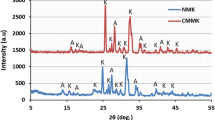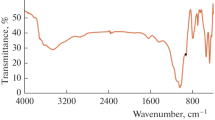Abstract
A sorption apparatus consisting of (1) a high vacuum system (<10−5 mm Hg), (2) an oil manometer to determine the equilibrium vapor pressure, (3) a quartz helix to determine weight of adsorbate, and (4) a constant temperature control for the adsorption chamber has been used to obtain water vapor sorption isotherms on kaolinite. Equilibrium between water vapor and the clay surface can be obtained in 2 hours with this equipment. The estimated error in relative pressure (P/P0) and amount of water adsorbed (X) are ± 0.001 and ± 0.07 mg H2O/g clay respectively. Reproducibility of sorption isotherms for clay samples similarly prepared are within these limits. When retested those clay samples that had stood in the laboratory for a few weeks gave sorption isotherms slightly different from the initial isotherm. This variation, while not excessive, seriously limited interpretation of the sorption data.
In order to study the variation of sorption characteristics with curing conditions, two samples were stored at an elevated temperature (70°C) under two different conditions of moisture content and pressure; one sample as a water slurry (1 g clay per 10 ml H2O) and the other completely dry in an evacuated (<10−5 mm Hg) container. The effect on the sorption isotherms was in both cases very marked but of a different character.
Compared with the sorption behavior of the initial Li kaolinite, the sample stored as a slurry showed greater water adsorption at all values of P/P0 and a disappearance of the marked hysteresis which persists to very low P/P0 on the initial sample; however, when stored in vacuo, Li kaolinite at all values of P/P0 adsorbed less water than the initial Li kaolinite. Data are presented to show that the sample stored as a slurry has been converted to an Al kaolinite. The reduced water sorption upon storage in vacuo is shown to be a permanent change.
Similar content being viewed by others
References
Brunauer, S., 1945, The adsorption of gases and vapors: Princeton University Press, Princeton, N. J., v. 1, 511 p.
Ernsberger, F. M., 1953, Temperature coefficient of the McBain sorption balance: Rev. Sci. Instr., v. 24, p. 998–999.
Mathers, A. G., Weed, S. B., and Coleman, N. T., 1955, The effect of acid and heat treatment on montmorillonoids: in Clays and Clay Minerals, Natl. Acad. Sci.—Natl. Res. Council, pub. 395, p. 403–412.
Mooney, R. W., Keenan, A. G., and Wood, L. A., 1952, Adsorption of water vapor by mont-morillonite. I. Heat of desorption and application of BET theory: J. Am. Chem. Soc., v. 74, p. 1367–1371.
Peech, Michael, Alexander, L. T., Dean, L. A., and Reed, J. F., 1947, Methods of soil analysis for soil-fertility investigations: U.S.D.A. circular 757, 25 p.
Peech, Michael, and English, L., 1944, Rapid microchemical soil tests: Soil Sci., v. 57, p. 167–195.
Schofield, R. K., and Samson, H. R., 1953, The deflocculation of kaolinite suspensions and the accompanying change-over from positive to negative chloride adsorption: Clay Minerals Bulletin, v. 2, p. 45–51.
Author information
Authors and Affiliations
Rights and permissions
About this article
Cite this article
Torrence Martin, R. Water Vapor Sorption on Lithium Kaolinite. Clays Clay Miner. 5, 23–38 (1956). https://doi.org/10.1346/CCMN.1956.0050104
Published:
Issue Date:
DOI: https://doi.org/10.1346/CCMN.1956.0050104




